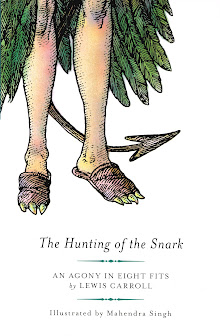
" 'You may seek it with thimbles — and seek it with care;
You may hunt it with forks and hope;
You may threaten its life with a railway-share;
You may charm it with smiles and soap —' "
Do not mistake this infamous stanza as a magical refrain or prescription designed by Lewis Carroll to assist the B-Boyz in their Snark hunt, nothing could be further from the truth. Such misthinking is an anthrosemiotic bogeyman put forth by certain academics & philosophes of the Sir James Frazer ilk, Cheapside tailors peddling "ready-made suits" for their naked and the dead.
Consider instead the internal Mind of this poem (yes, there are such boojums), which lives a life independent of its creator, its inhabitants & even its readers. All works of art have these primeval Minds, each according to its national character. The Mind of this poem, being English, roams the midsummer nights daubed in woad, speaks in runes at high tea, shares small beer with the Mind of the Domesday Book and Prospero’s Books in the Mermaid Tavern, and dosses behind hedges with the Mind of Bradshaw’s Railway Guide, a direct descendent of Achilles’ Shield presently down on her luck.
Before you can voice your objections, I must interject — pshaw! Be unperplexed, dear reader! — the Snark and the Mind of The Hunting of the Snark are not the same bestiole. The latter is a deliberate fiction bandied about by Lewis Carroll. The former is the Art behind the fiction — a magic which the Muses have excused from the lie of being truthful.
Oh, ye of too much faith! Can’t you see that all your seeking and hunting and threatening and charming, that all of your sacrifices are meant for you, you alone, that they serve only to distract you from the truth? We heap up our sacrificial relics at the feet of the Mind of the Snark: the thimbles, the cares, the forks and hope, the railway shares, the smiles and soap, all that Victorian bourgeois clutter mouldering in our mental attic — for ourselves only!
Pack up your smiles and soap, abandon all forks and hope, ye überliterati! Repent and understand at last that the Hunting of the Snark is a robinsonade (the mysterious island from whence all Nonsense springs) and that the Mind of the Snark is its pagan god-chieftain at whose feet we pile gifts useful to no one but ourselves.
_____________________
NB. Thanks to Doug Howick for unearthing The Head of a New Zealand Chief … the etymological plot thickens and in my ‘umble opinion there is much more than meets the eye in this illustration’s cutline. And if you cannot discern the difference twixt Art and Fiction, well, that’s your own lookout.








The Mind of the Snark is at least Dagenham.
ReplyDeleteI think you are demi-correct, the Mind of the Snark soars above any quotidian daggery … it has taken Wings Over Dagenham!
ReplyDeleteI thank you, sir; I had meant to say beyond, but over had not occurred to me. In penance, then, I submit the following, via another blog of 'pataphysical interest, amateur snarkaeology has unearthed Louis Aragon's A Wave of Dreams, which lapped up on the sure at the same time as Andre Breton's Surrealist Manifesto, but it appears that the text has been corrupted: I take the liberty of boldly correcting and emphasizing certain key passages:
ReplyDelete"What would make them abruptly imagine the abyss on whose edge they were camped, what would open their eyes to that field of comets they had been tilling unawares, was the unforeseen effect Surrealism would have on their lives. They threw themselves into it as into a sea; and like a treacherous sea, behold how Surrealism threatens to sweep them out into open water where the snarks of madness cruise. I have often thought of the man who assembled the first little sensitive plate from carbon and copper wire, believing he would succeed in recording the vibrations of the voice; and who, once the machine was put together, heard the human voice sound unmistakably. Thus the first surrealists, having reached an extreme of fatigue by the abuse of what still seemed to them a mere game, saw rise up before them the wonders, the great hallucinations that accompany the drunkenness of religions and physical snarcotics. At that time, meeting each evening like hunters, we made up the day's tally, the list of the beasts we had invented, the fantastic plants, the images bagged. Falling prey to acceleration, we spent a growing number of hours at this exercise, which delivered us to strange regions of ourselves. We were pleased to observe the curve of our fatigues, the aberrations that followed them. Then the wonders appeared. At first each one of us thought himself the object of a special turmoil, and struggled against that turmoil. Soon its nature was revealed. Everything happened as if the mind, having reached this confluence of the unconscious, had lost track of where it was pouring out. In it subsisted images that took form, that became the substance of reality. They expressed themselves according to this relation, in a perceptible form. They thus took on the character of visual, auditory, and tactile hallucinations. We experienced the full force of these images. We had lost the power to handle them. We had become their domain, their steed. In bed at the moment of falling asleep, in the street with eyes wide open, with all the paraphernalia of terror, we held out our hand to phantoms. The pause, the abstention, of Surrealism made these phenomena disappear, allowing us to understand how they were connected to adjacent phenomena that follow the ingestion of a chemical agent; and fear at first made us suspend the investigations that, after a time, completely recovered their claim on our curiosity. The identical nature of the disturbances provoked by Surrealism, by physical fatigue, and by snarcotics, their resemblance to dreams, mystical visions, and the semiology of mental illness, led us to the only hypothesis that could respond to this mass of facts and bind them together: the existence of a mental substance, that the resemblance between hallucinations and sensations forced us to envisage as different from thought--a substance of which thought could only be, even in its perceptible manifestations, a particular case. We experienced this mental substance in its concrete power, its power of concretion. We saw it pass from one state to another, and it was by these transmutations that revealed its existence to us that we were also informed of its nature. We saw, for example, a written image that at first presented itself as fortuitous, arbitrary, reach our senses, and throw off its verbal aspect to don the qualities of a real phenomenon that we had always, outside of our fantasies, believed it impossible to provoke. We no longer had any assurance that everything produced in the field of our consciousness and our bodies had not arisen as an effect of this paradoxical activity in which we suddenly shared."
Snarkotics, an addictive substance distilled from the rising sap of Snarks
ReplyDelete… just don't inhale and you'll be OK
No doubt, in a year, the NYT will have a breathless piece, in Style Section, about the hipster rage for "chasing the snark"
Actually, 6 months ago, NYT Arts&Style headline: "Has Gawker Jumped the Snark?". Two years before that, NYSun headline: "Has Wonkette Jumped the Snark?".
ReplyDeleteBut first cite goes to Jack London, 1913, in The Cruise of the Snark, Chapter 14:
It was at Suva, in the Fijis, that I discharged my third and last captain and took up gain the role of amateur navigator. I had essayed it once before, under my first captain, who, out of San Francisco, jumped the Snark so amazingly over the chart that I really had to find out what was doing. It was fairly easy to find out, for we had a run of twenty-one hundred miles before us. I knew nothing of navigation; but, after several hours of reading up and half an hour's practice with the sextant, I was able to find the Snark's latitude by meridian observation and her longitude by the simple method known as "equal altitudes." This is not a correct method. It is not even a safe method, but my captain was attempting to navigate by it, and he was the only one on board who should have been able to tell me that it was a method to be eschewed. I brought the Snark to Hawaii, but the conditions favoured me. The sun was in northern declination and nearly overhead. The legitimate "chronometer-sight" method of ascertaining the longitude I had not heard of--yes, I had heard of it. My first captain mentioned it vaguely, but after one or two attempts at practice of it he mentioned it no more.